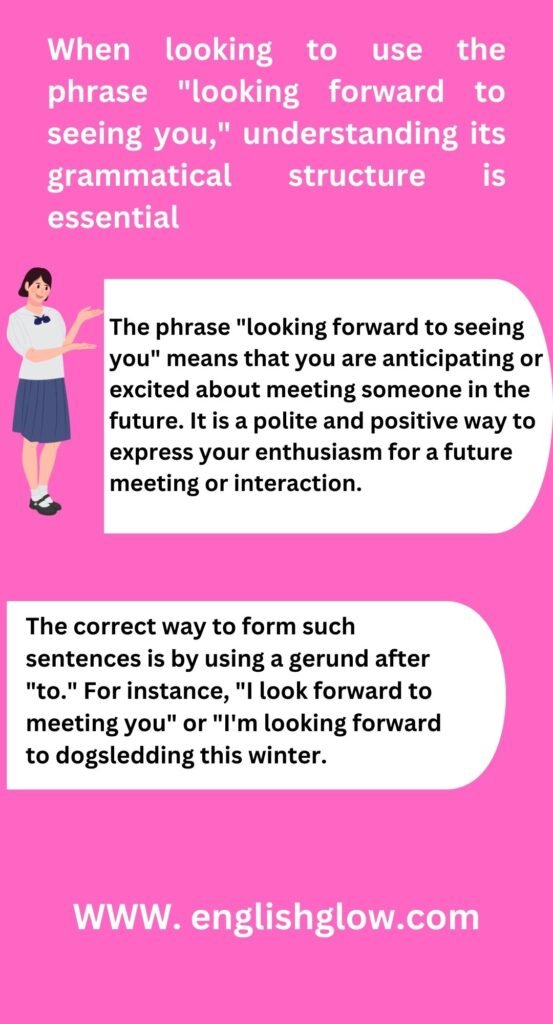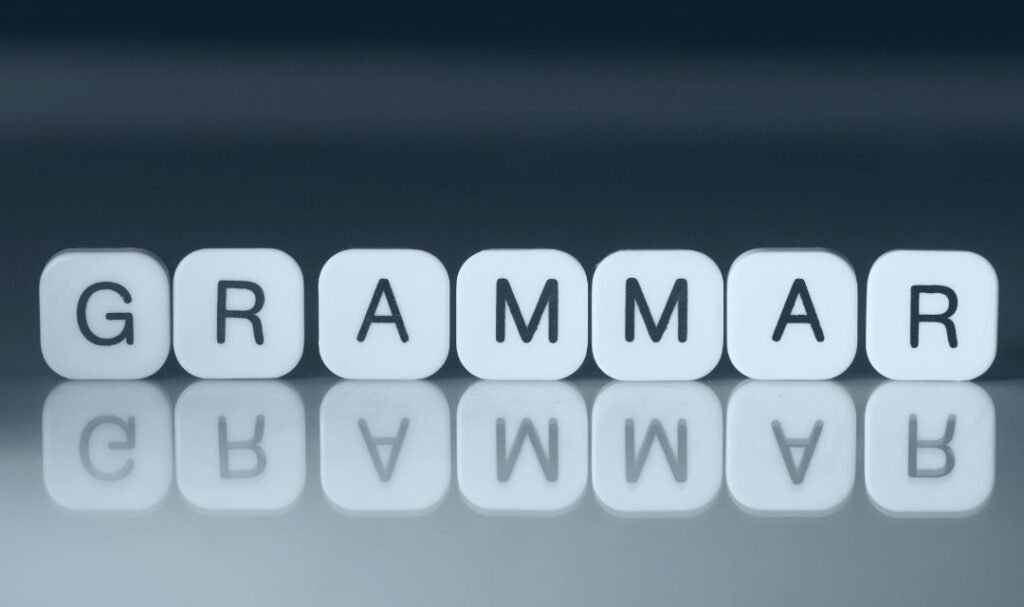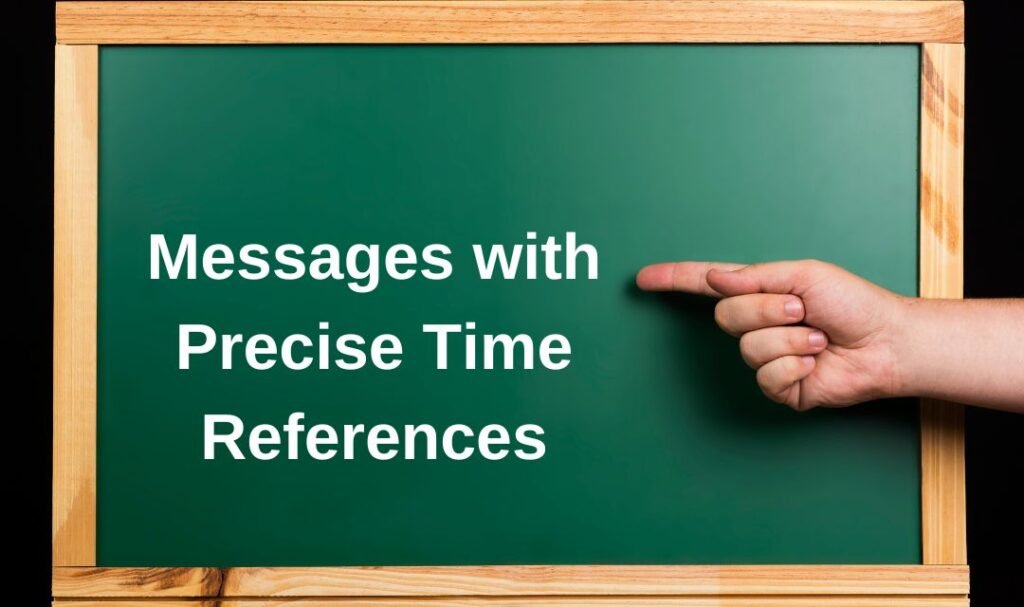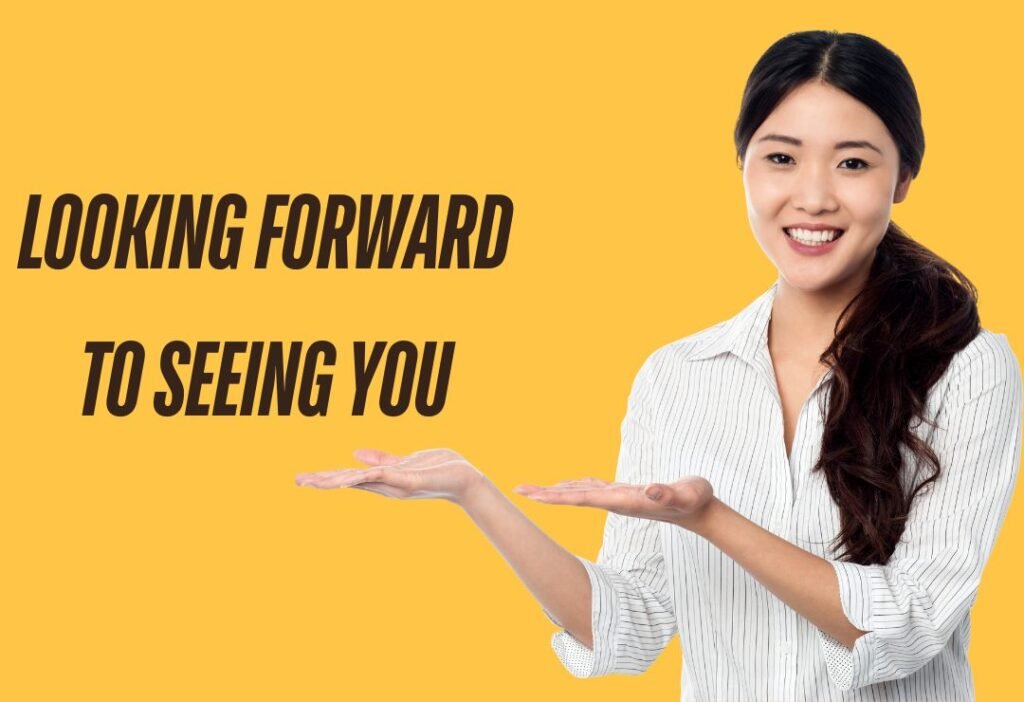Looking forward to seeing you” is more than just a polite phrase—it’s a warm and natural way to share your excitement about meeting someone. But how do you use it correctly? Don’t worry! This guide breaks it down simply, so you can express eagerness with confidence, whether in emails, messages, or everyday conversations.
We’ll explore the grammar behind this common expression (like why we say “seeing” instead of “see”) and share easy examples to help you practice. You’ll also learn how small changes—like swapping “seeing” for “meeting”—can subtly shift the tone. By the end, you’ll know exactly when and how to use this phrase to sound both friendly and fluent.
Ready to make your English sound more natural and heartfelt? Let’s get started!
Explanation

Looking forward to seeing you” might seem confusing at first. Why? Because in English, we usually learn that after “to”, we use the simple verb form (like “to eat” or “to dance”). But in this phrase, “to” isn’t part of an infinitive—it’s actually a preposition (like in “I go to school”). And after prepositions, we need a noun or something acting like a noun. That’s where the -ing form (or gerund) comes in!
What Does “Looking Forward to Seeing You” Mean?
Here’s a warm, learner-friendly rewrite that keeps all key information while making it more engaging and practical:
“Looking forward to seeing you” is a friendly way to say:
“I’m excited about meeting you soon!”
Grammar and punctuation errors

Using “looking forward to seeing you” correctly helps you sound friendly and polished! But English learners often make two small errors with this phrase. Let’s fix them together:
Professional Context

In work emails or meetings, this phrase is a polite way to show enthusiasm while keeping your tone warm and respectful. It tells colleagues or clients:
“I value our upcoming time together and am excited to connect!”
Family Context for
When you tell loved ones “I’m looking forward to seeing you!”, you’re sharing joyful excitement about reuniting—like giving them a verbal hug . It’s perfect for:
-
Holidays: “Can’t wait for Christmas together!”
-
Visits home: “So excited to hug you next month!”
-
Video calls: “Really looking forward to seeing your faces on Zoom!”
Romantic context
When you’re excited to see your partner, this phrase becomes emotional sunshine—it shows happy anticipation and wraps your feelings in warm, simple words. It’s like saying:
“You’re on my mind, and being with you makes my heart glow!”
Academic context
Use this phrase to share excitement about learning together! It’s a great way to motivate classmates or study partners while sounding friendly and supportive.
Volunteer context
Use this phrase to share excitement about community work and inspire your team! It’s a friendly way to say:
“I’m excited to work with you—and together, we’ll make a difference!”
Understand the concept
This phrase uses the present continuous tense (am/is/are + -ing) to share excitement about future plans. Think of it like holding up a mental calendar with a big smiley face 😊!
Enhancing Messages with Precise Time References

Adding specific times to “I’m looking forward to seeing you” turns excitement into clear plans! It’s like giving someone a mini-map 🗺️:
“I’m excited AND I know exactly when we’ll meet!”
Crafting Messages in Formal and Informal Styles
This phrase adapts perfectly to any situation—you just tweak the words around it! Think of it like clothing:
👔 Formal = Suit (structured, polite)
👕 Informal = Favorite T-shirt (relaxed, personal)
Using a Formal Tone
When inviting someone to an important event (like a charity gala or conference), your words should match the occasion’s significance. A polite, respectful tone makes guests feel valued while keeping things professional.
Using an Informal Tone
In relaxed settings with friends or family, this phrase becomes warm and personal—like giving someone a high-five through words! Swap stiff language for natural expressions that match your relationship.
Is “Looking Forward to Seeing You” Formal or informal?
Great news! This phrase works perfectly in both settings – it’s like a chameleon 🦎 of English expressions! Whether you’re writing to your boss or best friend, here’s how to adapt it:
How to Politely Say “Looking Forward”?

Using “I look forward to…” is your go-to phrase for polite, respectful anticipation in English. It’s like a warm handshake in words 🤝—friendly but professional. Works great in emails, meetings, or formal chats!
How to Express “Looking Forward” in a Professional Way
When writing emails or speaking in professional settings, these polished alternatives show enthusiasm while keeping your tone respectful and confident. Think of them as business attire for your words 👔—appropriate and sharp!
What can I write instead of looking forward to?
Swap overused phrases with these natural alternatives! Like choosing pizza toppings 🍕, pick the one that fits your situation best.
🔹 Formal & Professional
| Phrase | Example | Use Case |
|---|---|---|
| I anticipate… | “I anticipate your feedback by Friday.” | Emails to clients/seniors |
| I await… | “I await the report with interest.” | Formal documents |
| I expect… | “I expect to finalize plans soon.” | Project updates |
🔹 Warm & Friendly
| Phrase | Example | Use Case |
|---|---|---|
| I’m eager to… | “I’m eager to collaborate on this!” | Team projects |
| I’m excited about… | “I’m excited about our trip next month!” | Social plans |
| I’m keen on… | “I’m keen on seeing your new design!” | Creative work (UK/AU/NZ) |
🔹 Casual & Enthusiastic
| Phrase | Example | Use Case |
|---|---|---|
| I can’t wait for… | “Can’t wait for the concert! 🎸” | Friends/family texts |
| I’m pumped for… | “I’m pumped for game night!” | Informal chats (US/CA) |
| Counting down to… | “Counting down to Saturday! ⏳” | Events/vacations |

